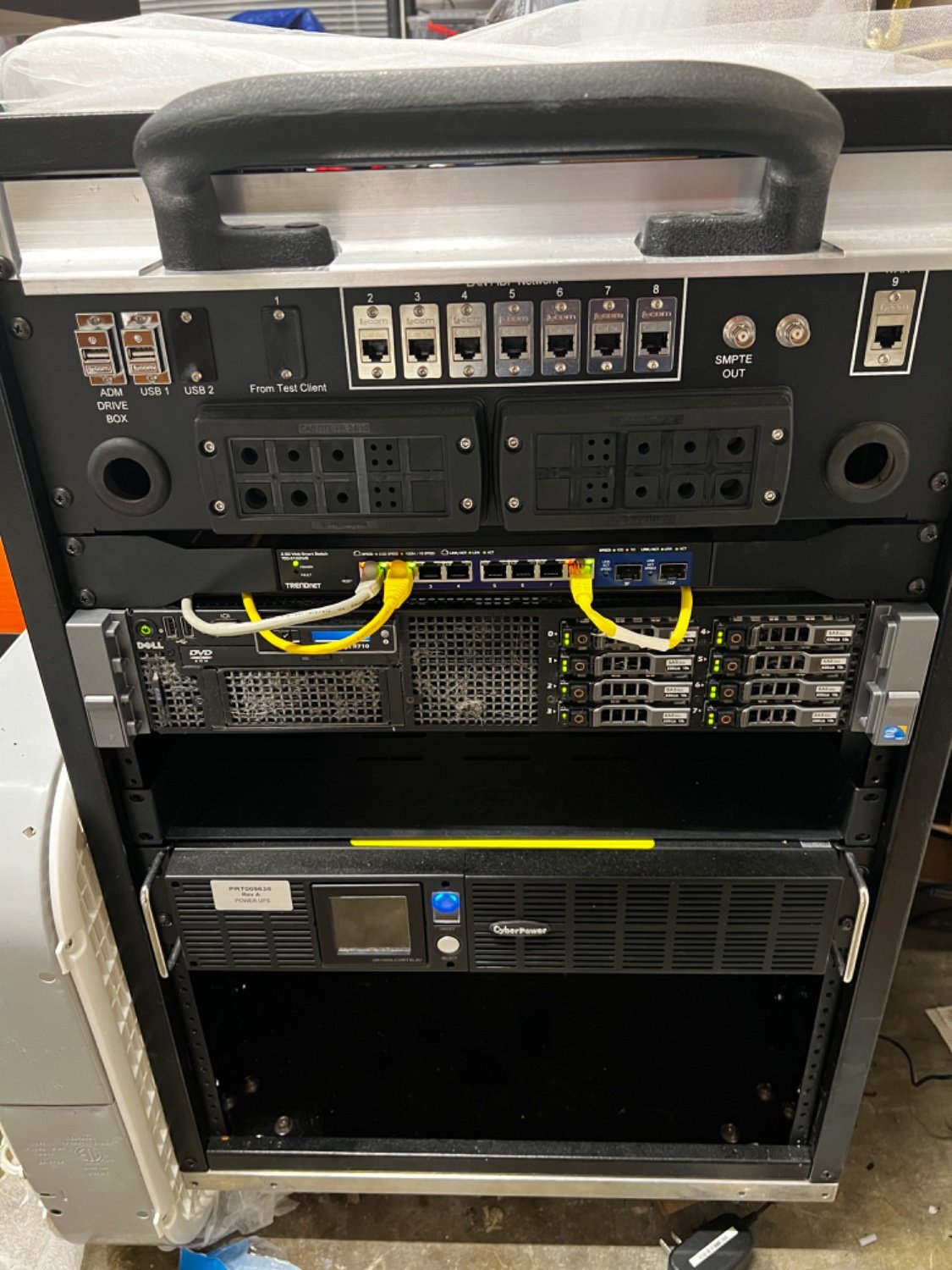For years I’ve had a dream of building a rack mounted PC capable of splitting its resources to host multiple GPU intensive VMs:
- a few gaming VMs
- a VM for work that can run Davinci Resolve and Blender renders
- an LLM server
- a Stable Diffusion server
- media server
Just to name a few possibilities…
Everytime I’ve looked into it, it seemed like the technology just wasn’t there yet. I remember a few years ago Linus TT took a shot at it, but in the end suggested the technology (for non-commercial entities) just wasn’t in a comfortable spot yet.
So how far off are we? Obviously AI focused companies seem to make it work, but what possibilities exist for us self-hosters who might also want to run multiple displays in addition to the web gui LLM servers? And without forking out crazy money for GPU virtualization software licenses?
The technology has “been there” for a while, it’s trivial do setup what you’re asking for, the issue is that games have anti cheat engines that will get triggered by the virtualization and ban you.
Which games do that? Running pasthrough gpu on windows for destiny and halo at least gave me 0 issues for years
Anything using vanguard such as valorant and league of legends, battleye such as pubg, destiny 2, and rainbow 6 siege, and easy anti cheat such as fortnight blocks virtual machines. Vanguard is especially bad because it will not allow to run the game with Intel-VT/AMD-V enabled even if you are running bare metal as of its last update.
this just makes me wanna install bare-metal goody-2-shoes windows and cheat using a 5$ arduino
That’s weird destiny 2 has never given me issue, though I don’t play super frequently so maybe I’m just lucky
Vanguard is especially bad because it will not allow to run the game with Intel-VT/AMD-V enabled even if you are running bare metal as of its last update.
The Vanguard anti-cheat is incredibly invasive and something akin to malware, so that’s not surprising.
I’m surprised, I was pretty sure anything with Battleye flat out rejected virtualization.
I thought Destiny used Battleye but I must be mistaken on one of these points.
deleted by creator
Most likely everything Steam + VAC or Denuvo. There’s a lot of discussion on that topic around the web.
I’ve been doing exactly that at home for a couple years now. First with Parsec, now Sunshine/Moonlight.
Host is Proxmox on Ryzen 5800x, 64gm RAM GPU is 2070 Super, with VGPU patched drivers from https://gitlab.com/polloloco/vgpu-proxmox
When I’m gaming I’ll dedicate the full 8Gb to my windows Vm, otherwise I split it in 2 or 4Gb chunks to Jellyfin or my home camera monitoring. 8gb can’t split very many ways, and most things require at least 2 to run.
Locally at home I can run 1440p 60fps rock solid over wifi on any device, from my phone/old laptop/apple tv/raspberry pi. Remote I can do 1080p60, but a bit more hit or miss depending on my network connection.
Experimenting with LLMs I’ve done through the same windows VM, or to a ubuntu dev VM. Works the same way. I’m thinking of transitioning my gaming VM to Linux too.
The amount of VRAM is the hard limitation to get past, the virtualization tech itself has been there for a while.
But to be perfectly honest……it really was just a “let’s see if I could do this” type task, direct GPU pass though is more straightforward and it’s not really worth splitting 8Gb these days. Unless you get a card with significantly more VRAM passthrough is much less work.
This is really amazing! In theory, can you can use 2gb with 4 different VMs?
Sure, but you’ll get diminishing returns most likely as consumer hardware doesn’t really have the resources to scale that way very well if all the VMs are running demanding apps simultaneously.
Even for something like 4 VMs that just do NVenc, there are limits for how many streams the GPU can do. I think there’s another patch that lets you raise that, but at some point you’ll run out of resources quick. Even powerful consumer gear isn’t really designed to be used by more than one user/app and it starts to show the more you virtualize and split those resources.
Hmm. I’m running a 3090 and 4090. Looks like vgpu is not possible yet for those cards.
Yeah unfortunately. 20xx is last generation supported so far via the patch, not sure if support for later cards is coming or not.
How does the vGPU compare to running it on the bare metal? Last I tried things were painful but technically usable.
I don’t see any performance differences with the vgpu actually. I have more performance bottlenecks with the CPU, and my RAM isn’t the fastest, so I think I’m more CPU limited. Benchmarks I have run that are GPU focused seem to show little to no difference from what the physical card would do.
Have you tried or do you have any knowledge about utilizing the display ports on the gpu while virtualizing either in lieu or in tandem with streaming displays?
No, but I think you’d have some problems. Only the host has access to the actual DisplayPort outputs, all the vgpus have virtual displays, I don’t think there’s a way to make them use the physical out.
I bought a cheap used Dell R710 on Facebook marketplace for like $100 or so, as well as an ups, rack, 10g switch, etc, from various other sellers. All told, I’ve got about $500 in my server setup.
Installed proxmox on it. It’s “free” if you don’t buy a license. You just have to put up with a little nag screen when you open the control panel but it still works 100%, much like winrar.
Works great.

Edit: just realized this is in c/selfhosted AND I misunderstood the post. I’m gonna leave it here just on the off chance it’s useful to somebody, but I acknowledge it’s not what you’re looking for.
Btw just in case you aren’t aware, the nag can be done away with. I don’t have a link off the top of my head but it’s out there.
I run a few servers myself with proxmox. FYI there is a script that removes that nag screen as well as configures some other useful things for proxmox self-hosters.
I’ve also wanted to do this for a while, but there were always a few too many barriers to actually spin up the project. Here’s just a brain dump of things I’ve seen recently.
vGPUs continue to be behind a license. But there is now vgpu_unlock.
L1T just showed off PCIe “fabric” from Liqid that can switch physical devices between machines.
Turning VMs on and off isn’t as slick as either of the above, but that is doable today. You’ll just have to build all the switching automation yourself. That could just be a shell script running QEMU/libvirt commands, at a minimum.
Here is an alternative Piped link(s):
L1T just showed off PCIe “fabric” from Liqid that can switch physical devices between machines.
Piped is a privacy-respecting open-source alternative frontend to YouTube.
I’m open-source; check me out at GitHub.
Why are vGPUs behind a license? They work fine on Linux as they are part of KVM and Virtio.
Why? Product segmentation I suppose. Last I looked, the Virtio project’s efforts were still work-in-progress. The Arch wiki article corroborates that today. Inconsistent behavior across brands and product lines.
What are you talking about? I though we were talking about Proxmox
The OP didn’t mention Proxmox in their post. I’ve been speaking generally, not about any specific OS. For example, Nvidia’s enterprise offerings include a license to use their “GRID” vGPU tech (and the enabled feature flag in the driver).
Thank you
I know you asked about VMs, but fwiw there are GPU-capable containers now: https://docs.nvidia.com/datacenter/cloud-native/container-toolkit/latest/install-guide.html
Used one of these and the setup is as easy as it sounds. It can run Houdini, Stable Diffusion.
You’re not really describing your use-case here. Are you just trying to run a server that does all your rendering for you so you can play games elsewhere? Yes, that’s totally possible.
If you’re trying to describe a business…no, it’s not possible, scalable, or profitable.
I’m curious as to what your intentions are here though.
I have a workstation I use for video editing/vfx as well as gaming. Because of my work, I’m fortunate to have the latest high end GPUs and a 160" projector screen. I also have a few TVs in various rooms around the house.
Traditionally, if I want to watch something or play a video game, I have to go to the room with the jellyfin/plex/roku box to watch something and am limited to the work/gaming rig to play games. I can’t run renders and game at the same time. Buying an entire new pc so I can do both is a massive waste of money. If I want to do a test screening of a video I’m working on to see how it displays on various devices, I have to transfer the file around to these devices. This is limiting and inefficient to me.
I want to be able to go to any screen in my house: my living room TV, my large projector in my studio room, my tablet, or even my phone and switch between:
- my workstation display running on a Window 10 VM
- my linux VM with youtube or jellyfin player I use as a daily driver
- a fedora or Windows VM dedicated to gaming, maybe SteamOS
- maybe a friend comes over for a LAN party and we both can game without having to set up a 2nd rig
- I want to host an LLM or stablediffusion server without having to buy a new GPU with enough VRAM to run SDXL
What you’re describing is mostly a networking issue. I’m also pretty suspect about your setup and wishes. You definitely don’t work for a large VFX studio, and you’re not using this as described for CAD work. I’m going to guess this entire setup is for your anime and incest rendering farm.
This is a ridiculous question for anyone with this amount of hardware in their home already that’s using it on a daily basis to actually work. You would also not be “running renders” if this was hardware provided by a company you work for.
Whatever is being asked here is for a shady ass person. Don’t help them.
… what?
Them: “I want a centralized place to handle all my graphics stuff, so I can access graphically intensive things from any device.”
You: “Must be incest renders because you already have hardware and say you use it for work.”
So according to you, contractors don’t exist, iPhones can play PC games, and anyone wanting to split PC resources between multiple use cases is shady.
What’s ridiculous is that you seem to think extreme paranoia is a normal thing in everyday life.
That’s such a weird leap in logic to jump to. Are you okay?
deleted by creator
I’m not the one making wild accusations about somebody wanting to selfhost a gpu server to edit…incest porn or whatever it is you’re on about.
No idea what lie you think I’m telling. 🤷♂️
Wow. Where is all this hate coming from?
People like to experiment, and tinker, and try things in their home lab, that would scale up in a business. Just to prove they can do it. That’s innovation. We should celebrate it. Not quash people
GPU passthrough has been pretty good for a while. The reason why Linus couldn’t get it working reliably was because iirc, he tried to do it on windows… I’ve done it before with a single gpu and have very recently set it up again, now that I have a 2nd one and gotta say, it’s pretty damn good…
How are you handling displays and keyboard/mouse? Also what VM software?
It goes over all of the steps of setting it up.
Here is an alternative Piped link(s):
Piped is a privacy-respecting open-source alternative frontend to YouTube.
I’m open-source; check me out at GitHub.
You can use proxmox to do most of this. Currently my set will only pass-through the gpu to one VM. I have heard of splitting the power among VMs but I have not gone down that rabbit hole. If I want to play with llms I fire up that server, if I want to game, I shut that down and fire up my windows 10 vm.
In Proxmox they have VirGL-GPU and Virtio-GPU. They allow VMs to pass work to the GPU without being dedicated to one VM. I don’t think gaming was the intended use case and don’t know what kind of performance you would get. My uninformed guess is that it would not be great.
I’ve always found the documentation around virtio-GPU and virtgl very lacking, and have never gotten them working. Would love to get pointers if anyone has a good source.
I currently have a setup exactly like this, with a threadripper 2950x, an RX 6600, and a 2070 super.
Let me know if you have any questions in the specifics, but its 100% possible
Best part of this setup is being able to connect to both via sunshine on many displays at once
I’m curious in a more in depth breakdown of your setup if you don’t mind. What is latency like and how are you handling switching?
I have a rack server in the garage with a gaming PC in it, 2 PSU’s and the 2 GPU’s mentioned, all running on Debian (which I soon plan to swap to nixos).
The AMD GPU’s is passed through to a windows VM with 8 gigs or so of ram, for VR development in the garage usually, but sometimes is streamed as well.
The second Nvidia GPU goes to my linux machine on Ubuntu just for ease of patched nvidia drivers, a couple virtual monitors with an xconfig like this, and is my daily driver with 16 gigs of RAM.
Both use Virtio drivers for disk, network, and anything else I’m forgetting, Pcie passthrough via KVM/QEMU on the host.
I’d say the latency hangs around 5ms when streaming both at once, and never comes close to saturating the gigabit connection, but I’m sure some optimisations could be done somewhere along the line.
Clients run on anything from an Xbox series X to a random PC, hopefully soon an orange pi (worried about latency though).
When I have a workload requiring both GPU’s I just keep 2 moonlight windows open and use the keybinds to unfocus the mouse then alt+tab to swap between them.
I don’t have any complaints, although one time when my thermal setup was worse I left 2 copies Subnautica running for my wife and I to at Nitrox together, and it did start to drop in fps on the Linux machine once we picked it up after an hour or 2 running the games AFK.
Edit to add I’m mostly using this for gaming right now, but its handled everything (within reason) that I’ve tossed at it, but I’m planning on soon setting up this sometime soon also across a couple other PC’s, but as of right now the VM’s feel as if they’re entirely distinct PC’s from an external perspective
Everytime I’ve looked into it, it seemed like the technology just wasn’t there yet. I remember a few years ago Linus TT took a shot at it, but in the end suggested the technology (for non-commercial entities) just wasn’t in a comfortable spot yet.
I had a sever in my basement running proxmox ( actually ended up doing it all manually eventually ), with a windows gaming VM and handful of utility Linux servers in 2015? The only problem being Windows games using kernel level anti cheat.
I get it really comes down to GPU sharing and I think it’s doable on consumer GPUs now but I’m not sure about gaming. Honestly the tech has been here for a long time. But companies like NVIDIA held on forever to the GPU resource sharing features and kept it away from consumer cards.
I’m a bit older these days and have gone through many generations of hardware with a different setup. I keep two or more GFX cards on hand. Latest always goes to my workstation while last gen is thrown in my sever and used by all my docker containers. Then have an older Xeon with 24 bays that I use for storage.
I’ve recently tried to do that using sunsine and different linux gaming distros and it was awful, the VM was working great for a few minutes and then suddenly crashes and I have to hard stop it.
All the people that I’ve seen talking about it on the internet are using Windows VMs so I guess that I’m doing something wrong or the only way to do it is through a Windows VM, which I’ll not even try.
I run a gaming Linux VM on my server and it works fine.
Could you explain how? I’m pretty lost in this situation…
Hey, sorry I didn’t reply until now but life has been pretty hectic and I also kinda borked my streaming VM right at the same time as I wrote that. I ran Nobara Linux for a while with KDE on Xorg and it actually worked pretty well. Then I decided I wanted to give Bazzite a try but I didn’t like the whole immutable thing. I went back to Nobara just to find that Steam Remote Play straight up didn’t work and I couldn’t know if I had failed to set up something properly or Valve just broke it while I was “away”. A couple of days ago I decided to just abandon Remote Play for the time being and deployed Games on Whales and it seems very promising so far. Much easier than fiddling with VM:s and GPU passthrough and Sunshine/Moonlight has never failed me.
No worries, LOL we followed exactly the same steps with the same problems, in fact, I was procrastinating documenting my problems in my Logseq and I think I’ll copy your explanation because it’s exactly my case in everything xd thanks ^^
I’ve recently tried to do that using sunsine and different linux gaming distros and it was awful, the VM was working great for a few minutes and then suddenly crashes and I have to hard stop it.
Are you running this with something like libvirtd/qemu? If so, VFIO configurations can get pretty complex. Random crashes seem like MSI interrupt issues (or you’ve allocated too much RAM to the guest). Or it could be GPU reset issues that would also occur on the (Linux) host, a newer kernel and Mesa version in the guest may help.
Setting on the kernel commandline for the host to workaround MSR interrupt crashes:
kvm.ignore_msrs=1
If you’re running on a Windows host or with something like Virtualbox (assuming GPU passthrough is supported by these), YMMV but I wouldn’t expect good results.
I’m using Proxmox with an NVIDIA 1050 GPU that I was passing through to another VM for jellyfin transcoding in docker (I don’t need it anymore), because of that I thought that the drivers were set up correctly.
The guest was Bazzite with 2 cores and 2 GB of RAM, I was not even gaming, just login on steam and updating the system and I had sudden crashes with Bazzite only using 1 GB on the Summary…
Ah Nvidia. Bazzite uses Wayland I believe since it uses the same gamescope session as SteamOS (unless something has changed recently). While it may be possible to get it working, I’d expect a much better time with an AMD card.
A traditional distribution may be a better bet with Nvidia for now.
Thanks, I’ve also tried to change the autologin with x11 with no success, I’ll try with nobara, but I really liked the console-like features
OK, but why?
Well, for fun and as a cool hobby project, I get that. That is enough to justify it, like any other crazy hobbyist project. Don’t let me stop you.
But in the spirit of practicality and speaking hypothetically: Why set it up that way?
For self-hosting why not build a few standalone machines and run off that instead? The reason to do this large scale is optimizing resources so you can assign a smaller pool of hardware to users as they need it, right? For a home set of two or three users you’d probably notice the fluctuations in performance caused by sharing the resources on the gaming VMs and it would cost you the same or more than building a couple reasonable gaming systems and a home server/NAS for the rest. Way less, I bet, if you’re smart about upgrades and hand-me-downs.
Yep this has been my hold up. It is mostly just a solution in search of a problem.
The best use case I have come up with is if you have an nice computer and an extra GPU laying around. You could turn the single computer into two workstation/gaming computers.
Yeah, but if you’re this deep into the self hosting rabbit hole what circumstances lead to having an extra GPU laying around without an extra everything else, even if it’s relartively underpowered? You’ll probably be able to upgrade it later by recycling whatever is in your nice PC next time you upgrade something.
At this point most of my household is running some frankenstein of phased out parts just to justify my main build. It’s a bit of a problem, actually.
Mainly because running multiple desktop machines adds up to a lot of power, even at idle. If you power them off and on as needed it’s better, but then it’s not as convenient. Of course, if you leave a single machine with multiple GPUs on 24/7 that will also eat a lot of power, but it will be less than multiple machines turned on 24/7 at least.
And the physical space taken up by multiple desktop machines starts to add up significantly, particularly if you live in an apartment or smaller house.
I guess that depends on the use case and how frequently both machines are running simultaneously. Like I said, that reasoning makes a lot of sense if you have a bunch of users coming and going, but the OP is saying it’s two instances at most, so… I don’t know if the math makes virtualization more efficient. It’d pobably be more efficient by the dollar, if the server is constantly rendering something in the background and you’re only sapping whatever performance you need to run games when you’re playing.
But the physical space thing is debatable, I think. This sounds like a chonker of a setup either way, and nothing is keeping you from stacking or rack-mounting two PCs, either. Plus if that’s the concern you can go with very space-efficient alternatives, including gaming laptops. I’ve done that before for that reason.
I suppose it’s why PC building as a hobbyist is fun, there are a lot of balance points and you can tweak a lot of knobs to balance many different things between power/price/performance/power consumption/whatever else.
I have upgraded my GPU on my desktop without upgrading anything else. Leaving me with a spare GPU and no other hardware.
Self hosting, I have also pulled GPUs out of systems to keep the power requirements down. As most of the time onboard GPUs are just fine for Self hosting applications. Also leaving me with a spare GPU.
However over the years GPUs have because more popular for processing there are more arguments to keep the GPU in a home server. So I can see how this is going away.
Maybe my situation is just unique, but due to my job I’m able to have a single workstation with multiple high VRAM GPUs. I wouldn’t be able to justify the cost of buying new GPUs and an entire rig just for gaming or AI image/video. I wouldn’t foresee more than 2 VMs using the GPU in high priority at any single time.
When I’m not working this system sits idle or is running renders. Why not utilize the amazing resources I have to serve my other needs?
OK, yeah, that makes sense. And it IS pretty unique, to have a multi-GPU system available at home but just idling when not at work. I think I’d still try to build a standalone second machine for that second user, though. You can then focus on making the big boy accessible from wherever you want to use it for gaming, which seems like a much more manageable, much less finicky challenge. That second computer would probably end up being relatively inexpensive to match the average use case for half of the big server thing. Definitely much less of a hassle. I’ve even had a gaming laptop serve that kind of purpose just because I needed a portable workstation with a GPU anyway, so it could double as a desktop replacement for gaming with someone else at home, but of course that depends on your needs.
And in that scenario you could also just run all that LLM/SD stuff in the background and make it accessible across your network, I think that’s pretty trivial whether it’s inside a VM or running directly on the same environment as everything else as a background process. Trivial compared to a fully virtualized gaming computer sharing a pool of GPUs, anyway.
Feel free to tell us where you land, it certainly seems like a fun, quirky setup etiher way.
I got stardew working on a local network and playing on the miyoo mini. It was cool for the novelty, but had terrible performance outside a local network. After only a couple of hops it’s unplayable and will disconnect.
I have used Sunshine + Moonlight over fibre + 5G based networks and its worked pretty nicely before. This was over Tailscale and routed over a DERP relay (worse latency, more hops due to CG-NAT). As long as your host internet speeds has good uploads and usable latency as well as your server/desktop connected wired to your router over Ethernet then it usually works well. Does depend on your network but it does work (and pretty well, as long as everything is configured properly), but YMMV.
Craft computing has been chasing this for several years now. His most recent attempt being the most successful one. https://m.youtube.com/watch?v=RvpAF77G8_8
Here is an alternative Piped link(s):
https://m.piped.video/watch?v=RvpAF77G8_8
Piped is a privacy-respecting open-source alternative frontend to YouTube.
I’m open-source; check me out at GitHub.
You should take a look at https://www.youtube.com/channel/UCp3yVOm6A55nx65STpm3tXQ he does have a serie about doing something like this and go in depth in it
Here is an alternative Piped link(s):
https://www.piped.video/channel/UCp3yVOm6A55nx65STpm3tXQ
Piped is a privacy-respecting open-source alternative frontend to YouTube.
I’m open-source; check me out at GitHub.
you beat me to it. this is the way.













